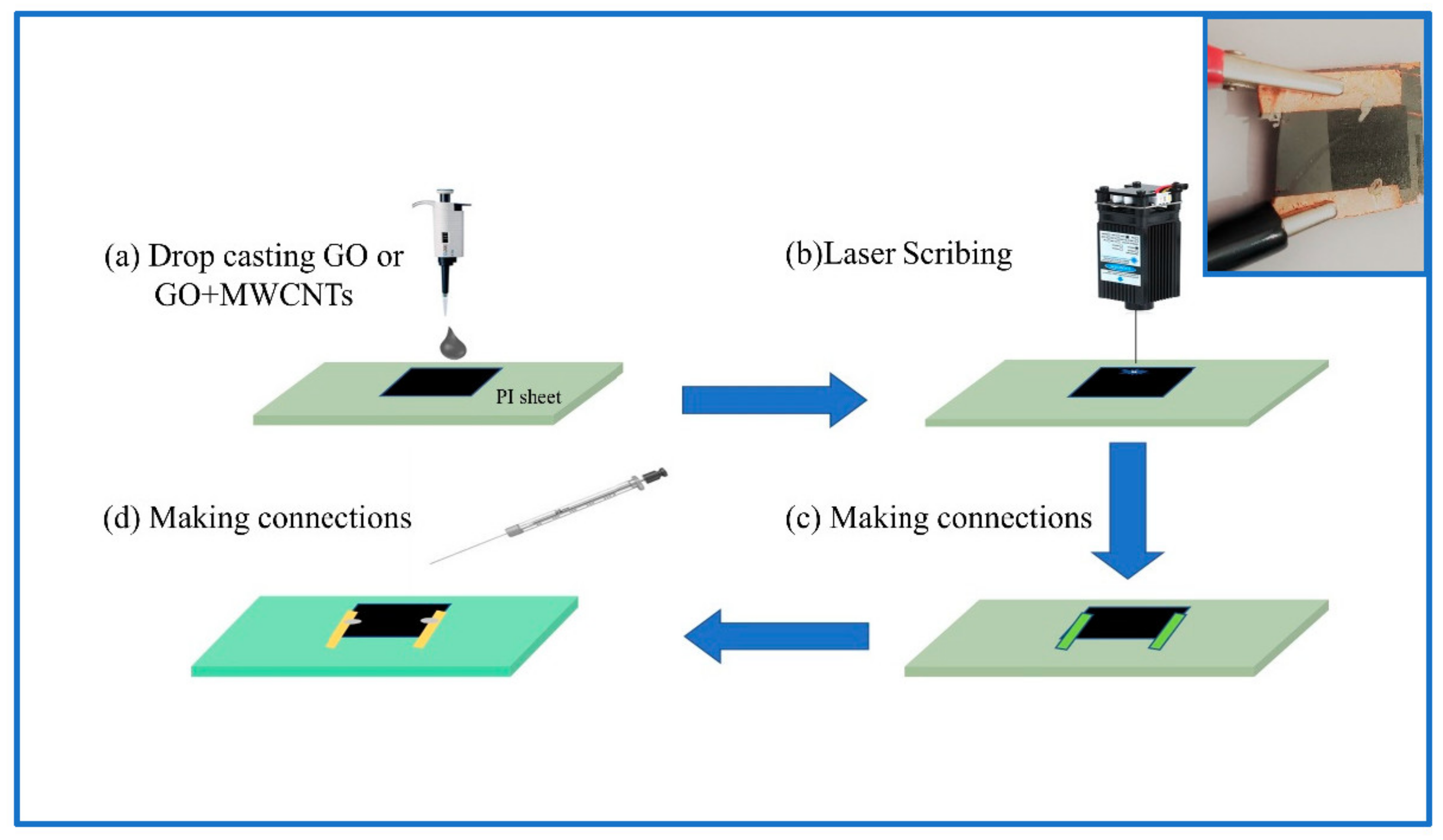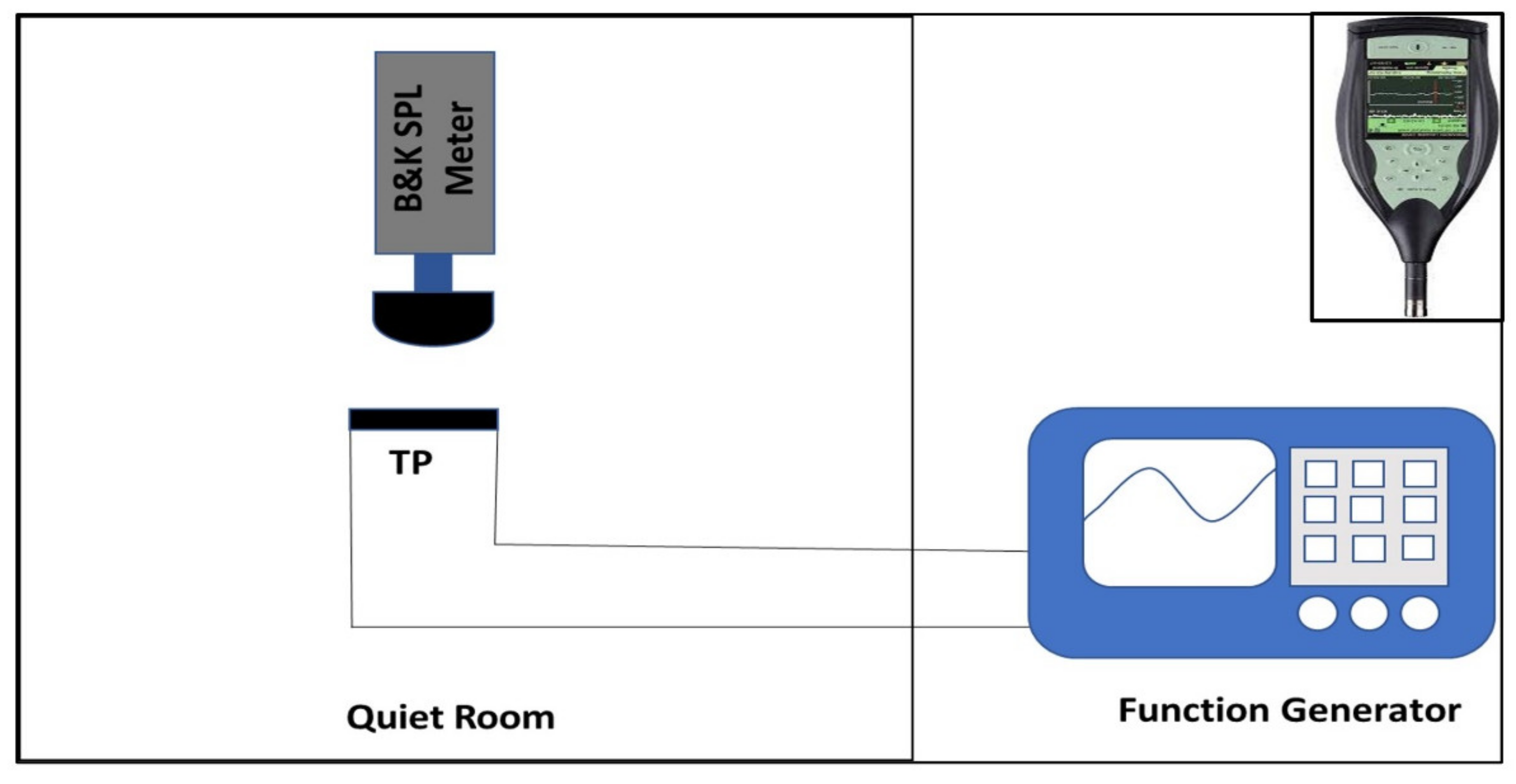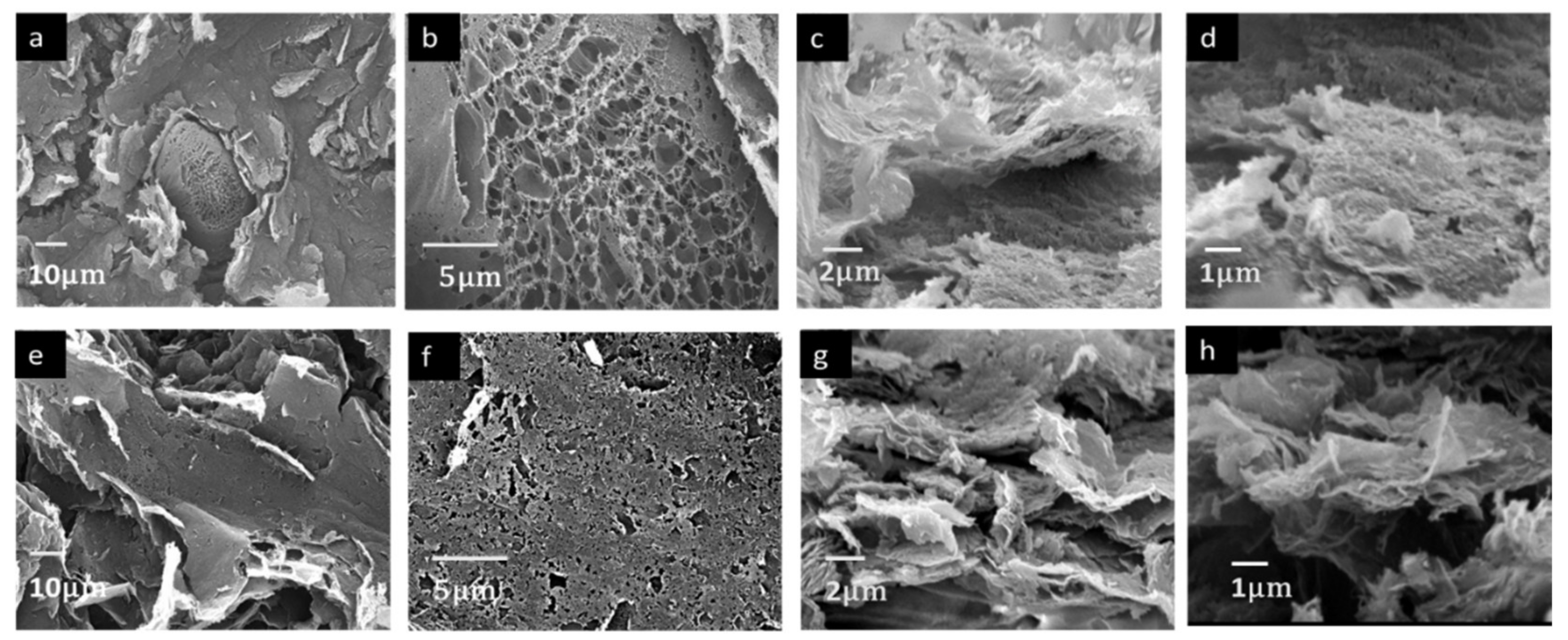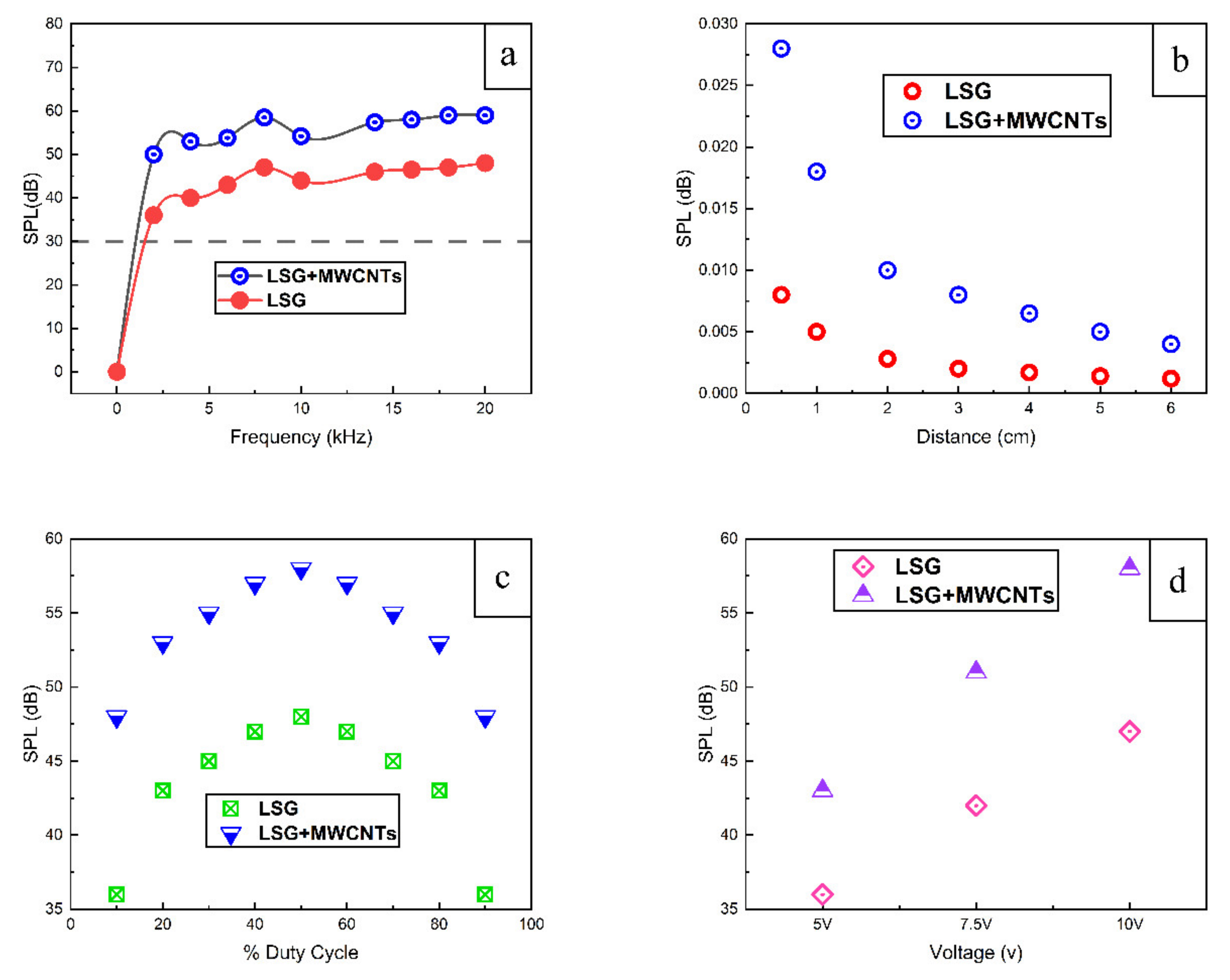Fabrication and Characterization of a Thermophone Based on Laser-Scribed Graphene Intercalated with Multiwalled Carbon Nanotubes
Abstract
:1. Introduction
2. Material and Methods
2.1. Material Synthesis
2.2. Structural and Electrical Characterization
2.3. Acoustic Characterization
3. Results and Discussion
3.1. Structural Characterization
3.2. Acoustic Characterization
4. Conclusions
Supplementary Materials
Author Contributions
Funding
Institutional Review Board Statement
Informed Consent Statement
Data Availability Statement
Acknowledgments
Conflicts of Interest
References
- Arnold, H.D.; Crandall, I.B. The thermophone as a precision source of sound. Phys. Rev. 1917, 10, 22. [Google Scholar] [CrossRef]
- Xiao, L.; Chen, Z.; Feng, C.; Liu, L.; Bai, Z.Q.; Wang, Y.; Qian, L.; Zhang, Y.; Li, Q.; Jiang, K.; et al. Flexible, stretchable, transparent carbon nanotube thin film loudspeakers. Nano Lett. 2008, 8, 4539–4545. [Google Scholar] [CrossRef] [PubMed]
- Mayo, N. Advancements in Thermophones: Sound Generation from Nanoscopic Heaters. Acoust. Today 2018, 14, 47–55. [Google Scholar] [CrossRef]
- Shinoda, H.; Nakajima, T.; Ueno, K.; Koshida, N. Thermally induced ultrasonic emission from porous silicon. Nature 1999, 400, 853–855. [Google Scholar] [CrossRef]
- Fei, W.; Zhou, J.; Guo, W. Low-voltage Driven Graphene Foam Thermoacoustic Speaker. Small 2015, 11, 2252–2256. [Google Scholar] [CrossRef]
- Tian, H.; Xie, D.; Yang, Y.; Ren, T.L.; Lin, Y.X.; Chen, Y.; Wang, Y.F.; Zhou, C.J.; Peng, P.G.; Wang, L.G.; et al. Flexible, ultrathin, and transparent sound-emitting devices using silver nanowires film. Appl. Phys. Lett. 2011, 99, 253507. [Google Scholar] [CrossRef]
- Dutta, R.; Albee, B.; van der Veer, W.E.; Harville, T.; Donovan, K.C.; Papamoschou, D.; Penner, R.M. Gold nanowire thermophones. J. Phys. Chem. C 2014, 118, 29101–29107. [Google Scholar] [CrossRef] [Green Version]
- Tian, H.; Yang, Y.; Li, C.; Mi, W.T.; Mohammad, M.A.; Ren, T.L. A flexible, transparent and ultrathin single-layer graphene earphone. RSC Adv. 2015, 5, 17366–17371. [Google Scholar] [CrossRef]
- Romanov, S.A.; Aliev, A.E.; Fine, B.V.; Anisimov, A.S.; Nasibulin, A.G. Highly efficient thermophones based on freestanding single-walled carbon nanotube films. Nanoscale Horiz. 2019, 4, 1158–1163. [Google Scholar] [CrossRef]
- Huang, W.; Li, P.; Le, X.; Zhang, X.; Gao, C.; Xu, Z.; Xie, J. Broadband and Fast Response Thermophone Using Graphene Nanofilm. In Proceedings of the 2019 IEEE 32nd International Conference on Micro Electro Mechanical Systems (MEMS), Coex, Seoul, South Korea, 27 January 2019; pp. 799–802. [Google Scholar]
- Kang, D.H.; Cho, S.; Sung, S.; Kim, Y.R.; Lee, H.; Choe, A.; Yeom, J.; Kim, M.P.; Kim, J.C.; Noh, S.M.; et al. Highly Transparent, Flexible, and Self-Healable Thermoacoustic Loudspeakers. ACS Appl. Mater. Interfaces 2020, 12, 53184–53192. [Google Scholar] [CrossRef]
- Romanov, S.A.; Alekseeva, A.A.; Khabushev, E.M.; Krasnikov, D.V.; Nasibulin, A.G. Rapid, efficient, and non-destructive purification of single-walled carbon nanotube films from metallic impurities by Joule heating. Carbon 2020, 168, 193–200. [Google Scholar] [CrossRef]
- Tao, L.Q.; Tian, H.; Liu, Y.; Ju, Z.Y.; Pang, Y.; Chen, Y.Q.; Wang, D.Y.; Tian, X.G.; Yan, J.C.; Deng, N.Q.; et al. An intelligent artificial throat with sound-sensing ability based on laser induced graphene. Nat. Commun. 2017, 8, 1–8. [Google Scholar] [CrossRef] [Green Version]
- Tian, H.; Li, C.; Mohammad, M.A.; Cui, Y.L.; Mi, W.T.; Yang, Y.; Xie, D.; Ren, T.L. Graphene earphones: Entertainment for both humans and animals. ACS Nano 2014, 8, 5883–5890. [Google Scholar] [CrossRef]
- Tao, L.Q.; Sun, H.; Liu, Y.; Ju, Z.Y.; Yang, Y.; Ren, T.L. Flexible graphene sound device based on laser reduced graphene. Appl. Phys. Lett. 2017, 111, 103104. [Google Scholar] [CrossRef]
- Wei, Y.; Qiao, Y.; Jiang, G.; Wang, Y.; Wang, F.; Li, M.; Zhao, Y.; Tian, Y.; Gou, G.; Tan, S.; et al. A wearable skinlike ultra-sensitive artificial graphene throat. ACS Nano 2019, 13, 8639–8647. [Google Scholar] [CrossRef]
- Marcano, D.C.; Kosynkin, D.V.; Berlin, J.M.; Sinitskii, A.; Sun, Z.; Slesarev, A.; Alemany, L.B.; Lu, W.; Tour, J.M. Improved synthesis of graphene oxide. ACS Nano 2010, 4, 4806–4814. [Google Scholar] [CrossRef]
- Wen, F.; Hao, C.; Xiang, J.; Wang, L.; Hou, H.; Su, Z.; Hu, W.; Liu, Z. Enhanced laser scribed flexible graphene-based micro-supercapacitor performance with reduction of carbon nanotubes diameter. Carbon 2014, 75, 236–243. [Google Scholar] [CrossRef]
- Cançado, L.G.; Takai, K.; Enoki, T.; Endo, M.; Kim, Y.A.; Mizusaki, H.; Jorio, A.; Coelho, L.N.; Magalhaes-Paniago, R.; Pimenta, M.A. General equation for the determination of the crystallite size L a of nanographite by Raman spectroscopy. Appl. Phys. Lett. 2006, 88, 163106. [Google Scholar] [CrossRef]
- Armano, A.; Buscarino, G.; Cannas, M.; Gelardi, F.M.; Giannazzo, F.; Schiliro, E.; Nigro, R.L.; Agnello, S. Influence of oxide substrates on monolayer graphene doping process by thermal treatments in oxygen. Carbon 2019, 149, 546–555. [Google Scholar] [CrossRef]
- Hao, Y.; Wang, Y.; Wang, L.; Ni, Z.; Wang, Z.; Wang, R.; Koo, C.K.; Shen, Z.; Thong, J.T. Probing layer number and stacking order of few-layer graphene by Raman spectroscopy. Small 2010, 6, 195–200. [Google Scholar] [CrossRef]
- Asadzadeh, S.S.; Moosavi, A.; Huynh, C.; Saleki, O. Thermo acoustic study of carbon nanotubes in near and far field: Theory, simulation, and experiment. J. Appl. Phys. 2015, 117, 095101. [Google Scholar] [CrossRef] [Green Version]
- Ghasemi Yeklangi, A.; Khadem, S.E.; Darbari, S. Fabrication and investigation of a thermoacoustic loudspeaker based on carbon nanotube coated laser-scribed graphene. J. Appl. Phys. 2018, 124, 224501. [Google Scholar] [CrossRef]
- Tian, H.; Cui, Y.L.; Yang, Y.; Xie, D.; Ren, T.L. Wafer-scale flexible graphene loudspeakers. In Proceedings of the 2014 IEEE 27th International Conference on Micro Electro Mechanical Systems (MEMS), San Francisco, CA, USA, 6 January 2014; pp. 556–559. [Google Scholar]






| Material | Excitation Conditions | Measuring Distance | SPL (dB) | References |
|---|---|---|---|---|
| LSG | 5 V AC+5 V DC, 1 cm2 | 1 cm | 35 | ACS Nano 2014 [14] |
| LSG | 1 W, 1 cm2 | 3 cm | 40 | Journal of Applied Physics 2015 [23] |
| LSG | 5 V AC + 5 V DC, 1 cm2 | 1 cm | 40 | 2014 IEEE 27th International Conference on Micro Electro Mechanical Systems [24] |
| LSG | 5 V AC + 5 V DC, 1 cm2 | 1 cm | 48 | This work |
| LSG+MWCNTs | 5 V AC + 5 V DC, 1 cm2 | 1 cm | 59 | This work |
Publisher’s Note: MDPI stays neutral with regard to jurisdictional claims in published maps and institutional affiliations. |
© 2021 by the authors. Licensee MDPI, Basel, Switzerland. This article is an open access article distributed under the terms and conditions of the Creative Commons Attribution (CC BY) license (https://creativecommons.org/licenses/by/4.0/).
Share and Cite
Rabbani, M.; Syed, A.W.; Khalid, S.; Mohammad, M.A. Fabrication and Characterization of a Thermophone Based on Laser-Scribed Graphene Intercalated with Multiwalled Carbon Nanotubes. Nanomaterials 2021, 11, 2874. https://doi.org/10.3390/nano11112874
Rabbani M, Syed AW, Khalid S, Mohammad MA. Fabrication and Characterization of a Thermophone Based on Laser-Scribed Graphene Intercalated with Multiwalled Carbon Nanotubes. Nanomaterials. 2021; 11(11):2874. https://doi.org/10.3390/nano11112874
Chicago/Turabian StyleRabbani, Moin, Aashir Waheed Syed, Syed Khalid, and Mohammad Ali Mohammad. 2021. "Fabrication and Characterization of a Thermophone Based on Laser-Scribed Graphene Intercalated with Multiwalled Carbon Nanotubes" Nanomaterials 11, no. 11: 2874. https://doi.org/10.3390/nano11112874
APA StyleRabbani, M., Syed, A. W., Khalid, S., & Mohammad, M. A. (2021). Fabrication and Characterization of a Thermophone Based on Laser-Scribed Graphene Intercalated with Multiwalled Carbon Nanotubes. Nanomaterials, 11(11), 2874. https://doi.org/10.3390/nano11112874







